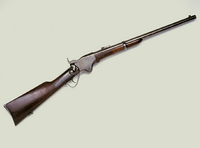








A repeating rifle is a single barreled rifle containing multiple rounds of ammunition. These rounds are loaded from a magazine by means of a manual or automatic mechanism, and the action that reloads the rifle also typically recocks the firing action. The term repeating rifle is most often applied to weapons in which the next cartridge is loaded by a manual action, as opposed to semi-automatic rifles, in which the force of one shot is used to load the next.
The Henry repeating rifle is a lever-action, breech-loading, tubular magazine rifle famed both for its use at Little Big Horn and being the basis for the iconic Winchester rifle of the American Wild West.
Designed by Benjamin Tyler Henry in 1860, "the Henry" was introduced in the early 1860s and produced through 1866 in the United States by the New Haven Arms Company. It was adopted in small quantities by the Union in the Civil War, favored for its greater firepower than the standard issue carbine. Many later found their way West, notably in the hands of the Sioux and Cheyenne in their obliteration of Custer's U.S. Cavalry troops in June 1876.
Modern versions of the weapon are produced by the Henry Repeating Arms (a reputedly exact replica) and A. Uberti Firearms (chambered for .44-40 Winchester and .45 Long Colt centerfire calibers.
The original Henry rifle was a sixteen shot .44 caliber rimfire, lever-action, breech-loading rifle patented by Benjamin Tyler Henry in 1860 after three years of design work.The Henry was an improved version of the earlier Volcanic Repeating rifle. The Henry used copper (later brass) rimfire cartridges with a 216 grain (14.0 gram, 0.490 ounce) bullet over 25 grains (1.6 g, 0.056 oz.) of gunpowder. Production was very small (150 to 200 a month) until middle of 1864. Nine hundred were manufactured between summer and October 1862; by 1864, production had peaked at 290 per month, bringing the total to 8,000 manufactured.By the time production ended in 1866, approximately 14,000 units had been manufactured.